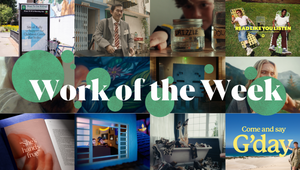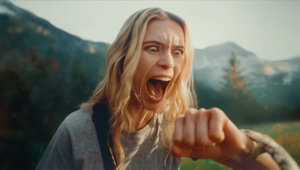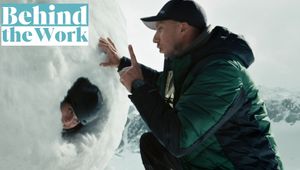
Behind the Work: The Humour and Humanity of the #WeThe15

As Tokyo wraps up the Paralympics, the International Paralympic Committee and the International Disability Alliance are hoping to build on the visibility and conversations raised by the games. #WeThe15 is a huge international movement that launched as the Paralympic Games kicked off, but it is much more than an ad campaign. The creators hope that #WeThe15 will provide an education platform and will help facilitate greater inclusion for people with disabilities around the globe.
The ambition and importance of the project’s goals cannot be understated: people with disabilities make up 15% of the world’s population - that’s over a billion people.
The campaign has been created with a broad, mass audience in mind - the website features resources for individuals, organisations and the media - but there is much that can be applied to the advertising and production industries. In the development of the strategy, creative and content, the teams at agency adam&eveDDB and production company Pulse worked to make sure the campaign was inclusive, and collaborated with organisations like Disabled Artist Networking Community and C Talent - and it’s also made all involved rethink inclusion and accessibility in their own corners of the industry.
In order to find out more, we spoke to Laura Rogers, global creative director at adam&eveDDB, Louis Lunts, business director at adam&eveDDB, and Pulse Films director Sam Pilling.
LBB> How did adam&eveDDB get involved with the project spearheaded by the IPC and International Disability alliance?
Laura & Louis> The IPC came to us just over two years ago with a surprising truth: they are the third largest sporting event in the world, but they’re not really about sports. Their real ambition is to change the lives of all people living with disabilities. So that was our brief. Tell the world what the IPC isn’t only about changing perceptions about para-athletes - but changing perceptions about the entire disabled community. To do that we needed to create a platform for them that the whole community could rally behind and own. #WeThe15 started as an idea on a scrap of paper at adam&eveDDB, first articulated by Edward Usher and Xander Hart, but over the course of developing with the IPC and the partner organisations, it grew from a line, to a campaign, to a movement that has the power to change lives.
LBB> What was the starting point for developing the campaign?
Laura & Louis> It all stemmed from a fact that shocked every person who heard it- people with disabilities make up 15% of the world’s population. That’s more than any of us thought and we knew that if it stopped us in our tracks, it would have the same effect on the world. The next thing that came to us was that any billion people is made up of all kinds of people, ordinary, nuanced, wonderful, human. But people with disabilities are rarely portrayed this way. This put emotional power behind the statistic.
LBB> Why was humour an effective approach? And given the international reach of the campaign, how tricky was it to make sure that the humour would land across cultures?
Laura & Louis> Humour was a mandatory straight from the start because that’s another thing that people never expect from people with disabilities. Disability is a subject often taken so seriously. But people with disabilities like a laugh just as much as anyone else- they have a sense of humour. So the campaign had to have a sense of humour too.
Sam> The unapologetic tone of voice in the script was one of the things I first fell in love with. The “yeah, we‘re superheroes alright” line felt so bold and arresting, and a great starting point for us to work with Selma, Gen, Laura, Rick and Hannah at adam&eveDDB on fleshing out each of the scenes. We went back and forth with the script and bounced lots of ideas around, we were constantly questioning: Is this too far? Or not far enough? The script was always a work-in-progress as once we had the cast in place, we consulted with each of them on what they felt comfortable saying, and what felt most true for them. Dan Edge was our lead disability consultant from C-Talent, and a key part of the pre-production process, helping craft the writing and making sure the wording and tone were absolutely spot on.
LBB> Sam, when you saw the idea, how did you approach the treatment and what were you keen to bring to it?
Sam> The whole idea is trying to butt up against the way society and the media so often portrays people with disabilities – either by holding them up as heroes on pedestals, or by pitying them and portraying them as victims.
For me it was all about being honest and authentic. No frills. No gimmicks. Just real, ordinary humans. It’s ultimately those people we are celebrating, and I wanted that portrayal to be as honest as possible, with an in-your-face portraiture of our characters who light up the screen with their warmth and personality.
That being said, we didn’t want to make an ‘ordinary’ film, so the humour was incredibly important. With our script and scenarios riffing off real life - and the situational humour that real life brings. An unapologetic cheekiness that says “this is life” – with all its ups and downs, it’s good and bad – and we live it the same way you do – sometimes we do or say the wrong thing, sometimes it’s funny, and sometimes it’s sad. But it’s always human.
LBB> And with so many stakeholders and partners, how did you collaborate with them in the development of the campaign?
Laura & Louis> Many of our stakeholders are people with disabilities, so it was critical to listen and include them. They are an amazing resource- a hotline to the lived experiences of people with disabilities around the world. The collaboration with them shaped the campaign and made it better.
LBB> Can you talk to us about the inclusion that went into the making of the campaign?
Laura & Louis> The campaign advocates inclusion, so we had to live it too. This started with a rigorous process of interrogating the language used in the campaign with the stakeholders and including many people with disabilities in the idea and script development. We had in advice of C-Talent, a brilliant consultancy dedicated to improving representation for people with disabilities in production. They guided us every step of the way, from script development, to casting, to making sure our set was accessible and that our talent felt safe and comfortable.
LBB> How did you approach inclusion behind the camera?
Sam> Working with C Talent and using resources like DANC (Disabled Artist Networking Community) we aimed to bring in as many crew with disabilities as possible, but it proved quite difficult, and unfortunately we didn’t meet our initial aim. There’s clearly a lot of work to be done to drive access and opportunities for disabled talent and its good to see organisations such as the BFI now support the industry with new guidance on improving the representation of disabled people on screen and behind the camera. It’s given us a lot to think about and how collectively we need to work to make the screen industry a more inclusive place for disabled people.

LBB> How did you approach casting?
Sam> I knew that the success of this piece was ALL about casting and finding our talent. And I knew that once we started that process, the scenes would morph and change and new scenes would develop from it. We worked with the brilliant casting director Anna Stark to find the majority of our UK talent, and had invaluable input from C Talent along the way too. I had several mammoth Zoom sessions where I met and auditioned the potential UK cast, and then did a similar thing for each of the other countries we were filming in. During one of the sessions in Cape Town, we met a couple called Frank and Cindy who I instantly fell in love with. They had such a bubbly upbeat nature and it transpired that they were newly married, so I thought it would be cool to have a wedding scene with a new line in the VO about getting married and meeting on a blind date. Max in Milan was another one… When we asked him if he ever pushed his baby in a stroller, he laughed and said “I am the stroller!” That became a line too and you can really feel the honesty in his performance as he delivers it.
LBB> The ad industry has been circling the issue of disability and inclusion for a few years, with a few notable campaigns but perhaps not a concerted push. Why is now the right time for such a huge global push across countries and across industries?
Laura & Louis> We’re so lucky here in the UK. We’ve been exposed to the work that Channel4 and a few others have done, which has changed the conversation around disability over the last decade. But the rest of the world hasn’t had the same opportunity and there was still a need to expand the discussion to represent all people with disabilities, not just athletes. What’s more, #WeThe15 is not just aimed at inclusion in advertising. It’s about inclusion and equal participation in life, everywhere. So we’re lucky to have the support of a huge coalition of government organisations, NGOs, sponsor and brands. But we’re not done! This launch is also our call to recruit everyone in the world to do what they can to change the lives of 1.2 billion people.

LBB> This is a massive global campaign and the film at least looks like it's been shot in multiple locations - given current restrictions, how did you achieve that?
Sam> The project was a huge undertaking, and the ambition from all sides was enormous. Everyone who worked on it, from beginning to end, fell in love with the idea and everything the script stood for, and they all went above and beyond to make the impossible happen for us and were so generous with their time, energy and expertise.
Given the film’s message, the global feel was non-negotiable. First, we decided which countries would give us the most diverse resources in terms of talent and locations, and then worked closely with Pulse’s global network of film-makers and production partners to make each shoot happen as best we could on the minimal resources we had. Pulse have just set up an office in Milan, and Giorgio Testi who runs it was keen to help out, so that was a no brainer. We’ve worked a lot with Beverley Wynne and her team at Gatehouse in Cape Town, and she and her line producer Karin Tanchel were incredibly supportive of the message of the film, and generously agreed to be involved. As did Nicholas Simon and Atrachariya Pinitsanpirom at Indochina Productions in Bangkok.
We shot the global parts of the film after our main shoot, so I pulled a bunch of Alex Barber’s frames (our UK DoP) as reference for what we had to capture in each country so all the DPs had a visual guide (including lens sizes etc) to work from.
Producer David French and I had back-to-back Zoom shoot days (or nights in Thailand’s case) where we sat on Zoom talking to the DP, 1st A.D, cast and crew, and someone on set pointed their camera at the monitor from time to time to make sure I was happy with the frame! I’m not going to lie; it was not the easiest way of working – but we all made it work with the resources we had available to us. Sometimes it was hard to know if we’d nailed the performance - as the image was too pixelated to see people’s faces clearly so I had to go off the sound and tone of their voice (with no playback either)
In Milan we were lucky enough to have director Tobia Passigato on the ground and he and I had a few meetings before the shoot and then communicated on WhatsApp on the day. I was signing off on takes via WhatsApp, which was definitely a first but worked out pretty well to be fair!
LBB> What were the most interesting aspects of the production from your perspective?
Sam> It has to be meeting and working with our talent. Getting to know them, and hearing their stories and points of views on everything from love, romance, football, Covid, travelling and how society views people with disabilities. It was humbling, inspiring and eye opening all at once. Our cast were there because of who they were. They weren’t playing a role or pretending to be anyone else, and that was a really interesting experience for me. In fact, at times, it felt like we were making a documentary. I had a real blast meeting and filming each of the talent and they are the ones that make the film what it is.
LBB> This campaign marks the ignition of what the coalition behind it hopes will be a massive human rights movement - can you talk to me about how the different aspects of the campaign will build on each other?
Laura & Louis> #WeThe15 is so much more than an ad campaign. The advertising element of it is enormous, but true change will only come when people, brands and organisations follow through support with action. So while most of the initial burst is focused on building awareness of #WeThe15, plenty of the work is built with the decade ahead in mind. We’ve created a suite of social content which will help educate the 85% in how to become allies to the cause; the IPC has built a website (www.WeThe15.org) full of resources to enable long-term change; and the IPC continues to collaborate with private and public sector partners around the world to facilitate their own inclusivity initiatives.
LBB> And what is the longer term plan and ambition for this movement in terms of keeping momentum up?
Laura & Louis> When the Paralympics end, the real work begins. True change won’t happen in three weeks. #WeThe15 will live long beyond Tokyo 2020 with activations around key cultural moments and a constant steady stream of support by partners. Watch this space.
LBB> Obviously this is a campaign that's trying to make change in the wider world, but how do you hope it will inspire change within the advertising industry when it comes to inclusion and representation and disability?
Laura & Louis> The agency has learned so much during this process, and we’re determined to ensure the change embodied by #WeThe15 is reflected in the industry that created it. People with disabilities are 15% of the world but are they in 15% of our work? 15% of our talent? 15% of our clients? We have already started to engage with industry bodies to progress the inclusivity agenda closer to home, and will continue to do so until the 15% is represented across the sector. We hope to publish some of this thinking later in the year.
LBB> And Sam, how did working on the film and getting involved in the campaign make you reflect on disability and representation and inclusion in filmmaking generally?
Sam> Working on the film was a truly eye-opening experience. After listening to our talent’s experiences it made me feel quite angry, and made me think about things differently, highlighting all the ways society is not set up for people with disabilities. This made me feel incredibly lucky, and highlighted how sheltered I had been to the issue, which only help spur my enthusiasm for the project
With regards to representation and inclusion in filmmaking generally, I think it’s very clear there is currently a huge disparity in our industry. The wheels of change are gradually turning and long may that continue. On this project specifically it felt like we had such a close-knit family of people from all walks of life, cultures, ethnicities and genders – all working together for a common, and incredibly important goal.
I mainly worked closely with the supremely talented creative force that is Gen & Selma! Who were awesome and a real breath of fresh air – pretty much embodying everything our script stood for; a zest for life, (sometimes brutal) whole-hearted honesty, and bags of fun and personality.
Whilst shooting the ad there were a few things I thought about – on one hand it’s great that we’re filming a project where our talent, who have a disability are the stars of the show, but wouldn’t it be even greater if they were the stars of our show and we were making a film for something else, something totally unrelated to disability?
Also, I was acutely aware that the majority of our crew was non-disabled. Now this was not for lack of trying. It was (and still is) incredibly busy out there and it was hard enough to find availabilities for certain roles (I think we searched over 160 people across the whole of the UK for a Playback op!) but never-the-less, it highlighted that just like all the other disparities we have with fair representation, collectively we need to work hard to ensure more people with disabilities are working in the film industry.















